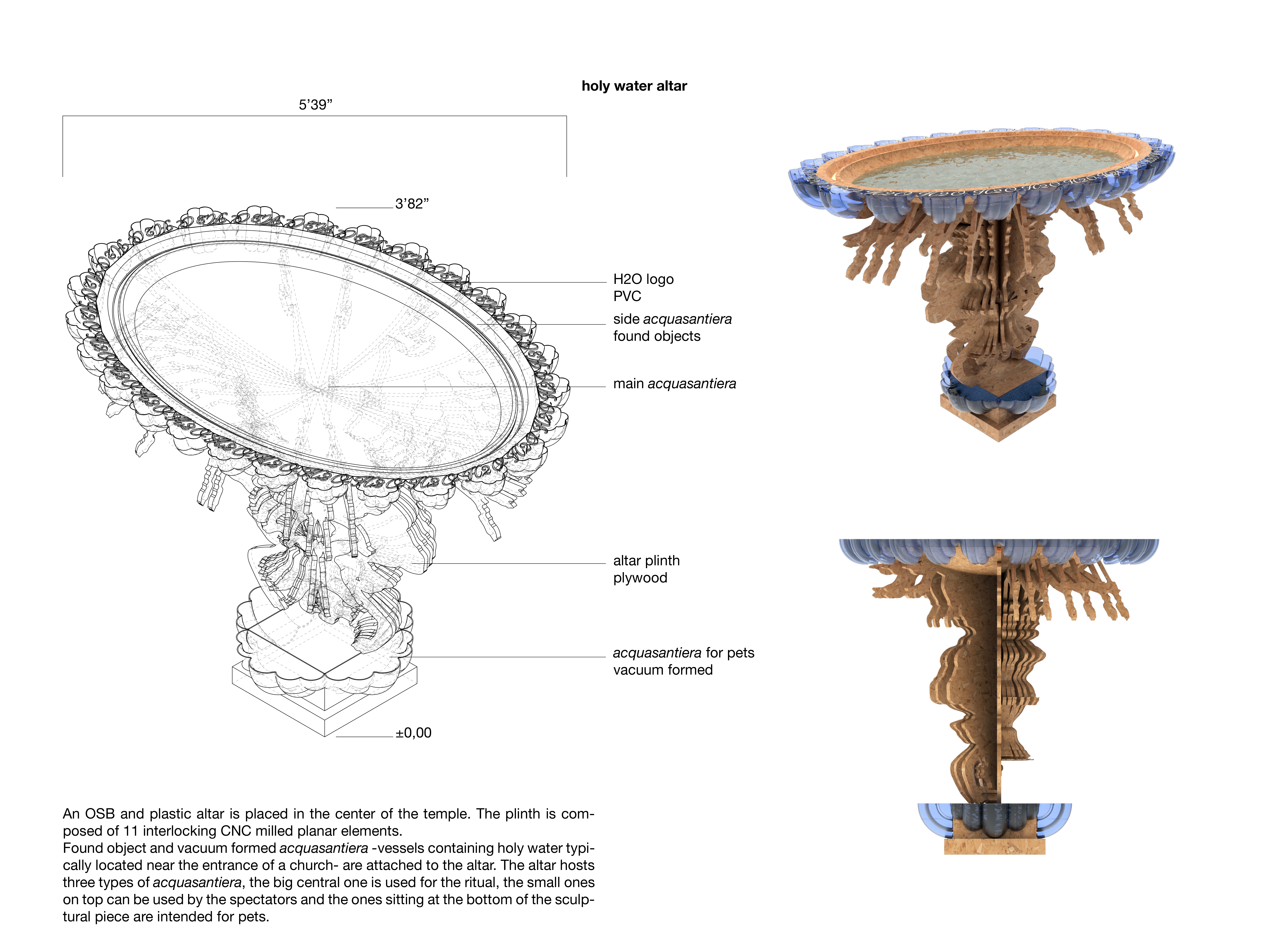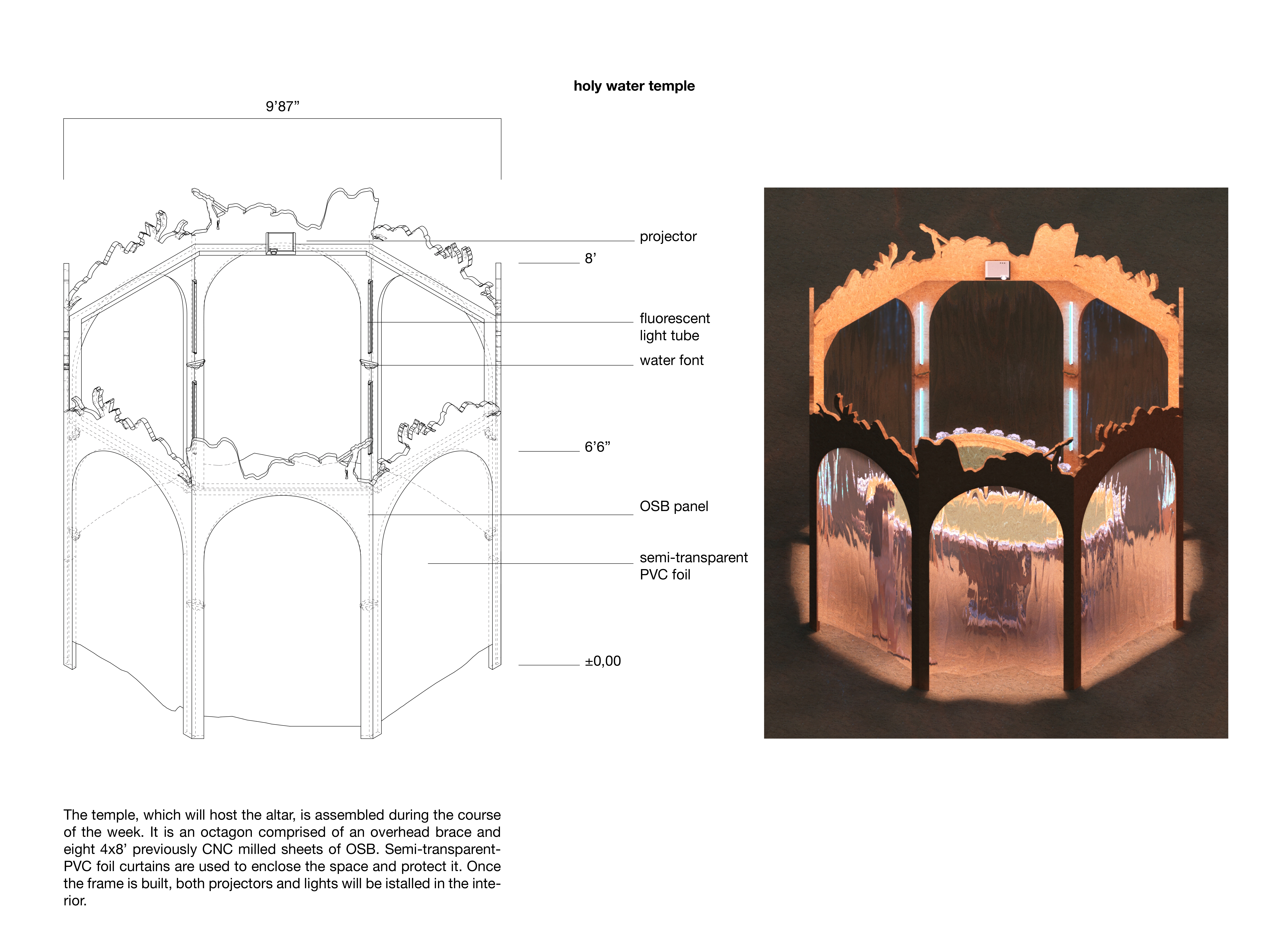Holy water,
An architectural performance to stimulate cultural awareness.
New Cuyama
Workshop proposal for Space Saloon
Team: Angelica Lorenzi, Hans Wendel
The project investigates rituals based on water. Much of the survival of desert peoples has long depended on their ability to locate, collect, and store water, and so it came to define much of their cultural conscious. This performance abstracts religion further into desert space, time and climate.

The relationship that architecture has with water is often similar to the relationship that it has with culture. While it may be effective in facilitating program, it does little to influence the conditions that brought that program into existence. In preserving Architecture’s autonomous qualities, or addressing its lack of agency in contemporary culture, we are continuously met by the ongoing difficulty of dealing with entities produced outside of the discipline. With the temple and altar, the aesthetics every day’s messy barrage of visual, material, and spiritual culture is up-cycled into a ritualized architecture.
 An architecture articulated through the spatial and emotional happenings it evokes serves as a performance enhancing drug for cultural development. Rituals activate symbolic links, claim identitarian needs, and depict qualitative hedonistic traits as physical spatial compounds. Spirituality and rituals often define and unite humankind, even if times are changing fast. The project is based on a form of contemporary and globalized ritual, where water is the key element. Much of the survival of desert peoples has long depended on their ability to locate, collect, and store water, and so it came to define much of the cultural conscious. The performance abstracts religion further into desert space and time. Participants are asked to try and immerse themselves in the vastness of the desert, in its solitude. Their perception of time is altered.
An architecture articulated through the spatial and emotional happenings it evokes serves as a performance enhancing drug for cultural development. Rituals activate symbolic links, claim identitarian needs, and depict qualitative hedonistic traits as physical spatial compounds. Spirituality and rituals often define and unite humankind, even if times are changing fast. The project is based on a form of contemporary and globalized ritual, where water is the key element. Much of the survival of desert peoples has long depended on their ability to locate, collect, and store water, and so it came to define much of the cultural conscious. The performance abstracts religion further into desert space and time. Participants are asked to try and immerse themselves in the vastness of the desert, in its solitude. Their perception of time is altered. The ritual will be composed of two acts; the first one, starting early in the morning involves a basic water-collection technique gleaned from aforementioned societies will be employed. Shallow holes will be dug near river beds, filled with leaves and other available herbaceous plants, covered in plastic, and allowed to heat up during the day. Water droplets will condense on the plastic and drip down into containers. The second part, at sundown, will consist of a performance that will take place around the altar assembled during the work shop day. Participants will bring the water from the condensation pits, in what we expect to be many precious small amounts, to the altar Water, found objects from site, alien objects, sounds and projection mapping will be used together to activate the architectural space.


The design for the installation’ and the altar is cultivated around the exploration of the non-architectural realm, searching for visual vocabularies that might cohere into an architectural language. The relationship that architecture has with water is often similar to the relationship that it has with culture. While it may be effective in facilitating program, it does little to influence the conditions that brought that program into existence. In preserving Architecture’s autonomous qualities, or addressing its lack of agency in contemporary culture, we are continuously met by the ongoing difficulty of dealing with entities produced outside of the discipline. With the temple and altar, every day’s messy barrage of visual, material, and spiritual culture is up-cycled into architecture. This approach to architecture is a radical alternative to the
sleek high speed curvature of self-referential objects, whose expressive forms tend to address contemporary culture only by exhibiting their apathy towards it. Dirty and involved, Hunter Gatherer Realism uses digital and physical bricolages to estrange reality rather than negate it. Thus design finds an epistemological foothold in the public conscious.

